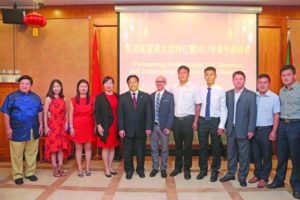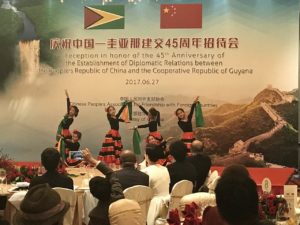By Chevon Lin
Guyana was the first English speaking Caribbean country to establish diplomatic relations with China, in 1972. One year later Guyana opened the doors to its Embassy in the capital city of Beijing.

This year, China and Guyana will commemorate the 46th Anniversary of diplomatic relationship, which is considered milestone in the bilateral relationship between the two countries. During this period, the two countries have fostered strengthened and have achieved new accomplishments.
China is the second largest trading partner of Latin America and the Caribbean, which is also a major destination for outbound Chinese investment, second only to Asia. China’s direct investment in Latin America and the Caribbean has exceeded US$150 billion.
Although 2018 will mark the 46th anniversary of diplomatic ties, the relationship between Guyana and China began as early as 1853. Chinese citizens from Guangdong province migrated to Guyana (then British Guiana), to assist with alleviating labour shortages across the country. Many of the descendants of these immigrants became influential members of Guyanese society, such that in 1970, Mr Arthur Chung, a man ofChinese descent, was appointed as Guyana’s first President. He was the first ethnic Chinese to be head of state of a non-Asian country.
Over the years the relationship between the two countries has continued to grow and strengthen. As such, Guyana is committed to redoubling its partnership with China in the international arena, to mitigate the modern scourges of poverty, underdevelopment, inequality, terrorism, transnational organized crime, and, in particular, the effects of climate change.
Investment and Cooperation
Guyana has witnessed a series of benefits through its increased cooperation with China politically, economically and culturally. Tangible improvements are being seen in such areas as transportation, infrastructure, information technology, health and security. Guyana has benefitted significantly from increased Chinese investment and the trade volume between both countries has tripled within the last decade. The recent discovery of oil serves to compliment the country’s core industries including forestry, mining, energy, agriculture, construction and manufactured goods. All of these assets continue to make Guyana a lucrative investment destination for Chinese companies.
The two nations remain further committed to a series of wide-ranging initiatives through the China-CELAC Forum, the principal vehicle for China-Caribbean cooperation. Guyana is the only English-speaking Caribbean nation that is located on the South American continent. As such, this country serves as a natural bridge between the Caribbean and South America and is home to the Caribbean Community (CARICOM) headquarters. With China becoming an increasingly more influential partner in the region, it stands to reason that its partnership with Guyana will continue to be one of strategic importance. The future remains bright and both countries will embrace the next 45 years of diplomatic relations with confidence and optimism.
According to a draft Policy paper by the Chinese Government, China sees itself as brining development opportunities to the rest of the world. It is estimated that in the next five years, China will import US$8 trillion of goods, invest US$750 billion overseas, and Chinese tourists will make 700 million outbound visits. All this will present an even bigger market, more capital, a greater variety of products and more valuable cooperation opportunities to countries around the world, including Guyana.
While enjoying deep diplomatic relations, China and Guyana hold similar views and have consistently echoed and supported each other’s positions, be it on key international issues such as UN reform, climate change, sustainable development, regional integration and cooperation between China and the Caribbean.
Over the years, the strong, comprehensive programme of bilateral cooperation has resulted in Guyana benefiting from the services of the Chinese medical doctors and technicians, the donation of equipment to the health sector, the educational work of the Confucius Institute, the support given to the Bertram Collins College of the Public Service, the donation of scientific equipment to the tune of $50 million to the Cyril Potter College of Education, infrastructural support for the expansion and renovation of the Cheddi Jagan International Airport (CJIA), the widening of the East Coast Demerara Public Road, and the donation of vehicles and other equipment to the Guyana Police Force and the Guyana Defence Force.
One Belt one Road Initiative
Latin America is driving faster on the path toward deeper involvement in and with China’s Belt and Road Initiative (BRI), this time with the Caribbean on board. This development occurred during the recent 2nd Ministerial Forum between China and the Community of Latin American and Caribbean States (Celac) held in Santiago, the Chilean capital, on Jan- 23.
Held under the theme ‘Celac-China: Working for More Development, Innovation and Cooperation for Our Peoples’, the meeting brought together 31 of the 33 member-states of the group of continental and island states, big and small, to facilitate a joint approach to the BRI.

The Silk Road Economic Belt and the 21st Century Maritime Silk Road were launched in 2013 with routes from China through Asia and linking to Europe and Africa. But Latin America soon indicated interest, as did several other regions.
Chinese Foreign Minister Wang Yi said the region was a natural fit for the initiative, which China has leveraged to deepen economic and financial cooperation with developing nations. The “One Belt, One Road” initiative, proposed in 2013 by Chinese President Xi Jinping, promotes expanding links between Asia, Africa and Europe, with billions of dollars in infrastructure investment.
The 1st Celac-China ministerial forum was held in Beijing in January 2015 and in the three years since much has happened to open a new Silk Road to Latin America – and now the Caribbean, as well.
CELAC, founded in 2010 and launched in 2011, is a key regional grouping established to facilitate closer, deeper and stronger regional integration between its 33 member-states. (Guyana Times Sunday Magazine)



